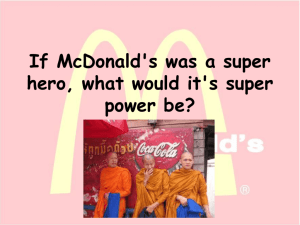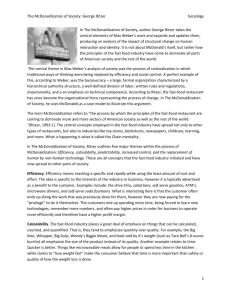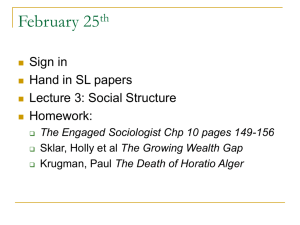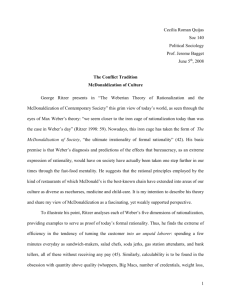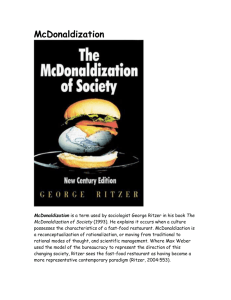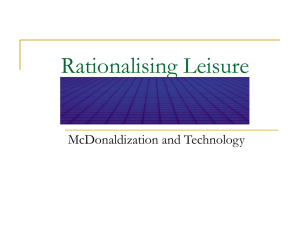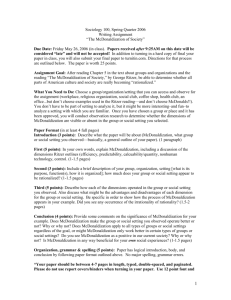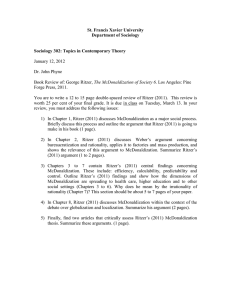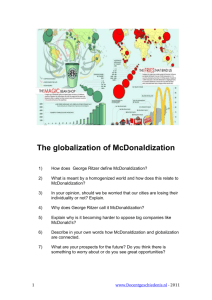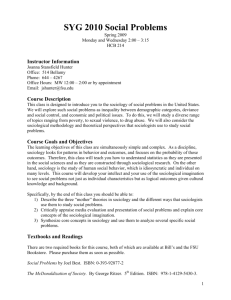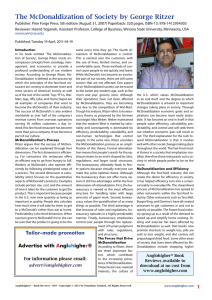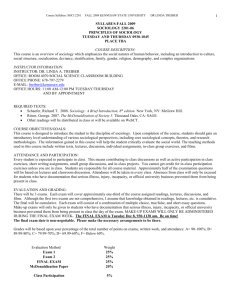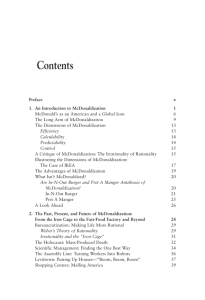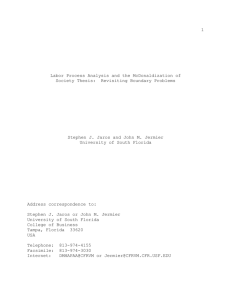Neoliberalism, Media, and Cultural Imperialism
advertisement
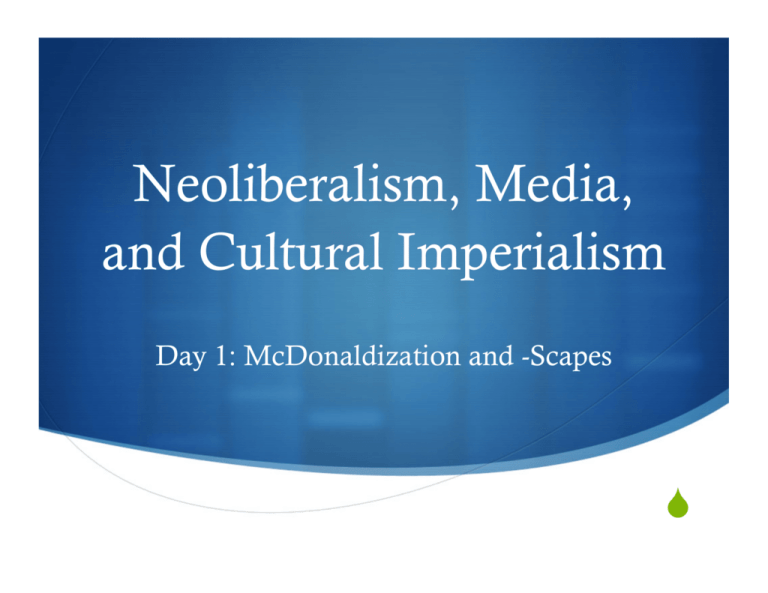
Neoliberalism, Media, and Cultural Imperialism Day 1: McDonaldization and -Scapes !" George Ritzer defines “McDonaldization” as “the process by which the principles of the fast-food restaurant are coming to dominate more and more sectors of American society as well as the rest of the world” (1). Ritzer coined this term in 1993 with the publication of the first edition of The McDonaldization of Society, now in its eighth edition. The term has since become part of the scholarly and popular lexicon in reference to various aspects of society and the globalization of culture. Ritzer sees McDonalization as “an inexorable process, sweeping through seemingly impervious institutions (e.g. religion) and regions (e.g., European nation such as France) of the world” (1). McDonalds has become a, if not the, symbol of American culture— a model that other chain retailers aspire to as they try to gain popularity with consumers across the globe. Over 43% of McDonalds restaurants are outside of the US and “well over half of McDonald’s revenue comes from overseas operations” (4). Ritzer’s central claim is that “McDonald’s has succeeded because it offers consumers, workers, and managers efficiency, calculability, predictability, and control” (14). It is these attributes that other businesses and cultural institutions try to employ to gain recognition and influence. He refers to these attributes as “Dimensions of McDonaldization”: ! Efficiency: “the optimum method for getting from one point to another,” i.e. the fastness of the food and the drive-thru ! Calculability: “emphasizes the quantitative aspects of products sold… and services offered” with little regard to quality. Ritzer notes, “The high profit margin of fast-food chains indicates that the owners, not the customers, get the best deal” (15). ! Predictability: “the assurance that products and services will be the same over time and locales… Customers take great comfort in knowing that McDonald’s offers no surprises” (15). ! Control: The use of specific, strict perimeters that constrain behavior according to the company’s wishes (those which maximize profit)—For customers this means ”lines, limited menus, few options, uncomfortable seats.” For workers this means being “trained to do a limited number of tasks precisely the way they are told to do them” (16). He includes a fifth dimension: “The Irrationality of Rationality” He states: “rational systems inevitably spawn irrationalities,” going on to say, “We must look at McDonaldization as both ‘enabling’ and ‘constraining.’ McDonaldization systems enable us to do may things we were not able to do in the past; however, these systems also keep us from doing things we would otherwise do. Mc Donaldization is a ‘double-edged’ phenomenon” (16-17). What does he mean by this? Can you think of any examples in our culture and society? Ritzer considers McDonaldization in comparison to what he sees as the four aspects of globalization: Practices: The practices put in place by McDonalds have been spread around the globe through not only fast-food chains but social institutions to produce efficiency and complacency (166) International Relationships: Connections between nations based on the growth of multinational corporations and international franchises (166-67). Organizing Social Life: Social life—including education and law enforcement— have been restructured for efficiency, resulting in less unique, personal experiences and greater homogeneity (167). Global Consciousness: People feel part of a global community and are more willing to travel to far off locales, but this is often a result of the perception that all places are relatively similar (that there will always be a McDonalds). While some people are comforted by this common culture, others attempt to avoid “places that they believe have become highly McDonaldized” (167). “Does global exchange involve increasing homogeneity or increasing heterogeneity or a mixture of both?” (167) Both Ritzer and Appadurai discuss the terms “homogeneity” and “heterogeneity.” These terms can be defined as fellows: Homogeneity: to make uniform throughout Heterogeneity: made up of distinct and diverse parts “Glocalization” Roland Robertson’s concept that “emphasizes the integration of the global and the local and involves far more heterogeneity than homogeneity… Glocalization can be defined as the interpenetration of the global and the local, resulting in unique outcomes in different geographic areas” (168). Can you think of examples of the “glocal”? What unique attributes persist in the McDonaldized world? Ritzer poses a companion term to glocalization: “Groblization” “Grobalization focuses on the imperial ambitions of nations, corporations, organizations, and the like and their desire, indeed their need, to impose themselves on various geographic areas. The main interest is in seeing their power, influence, and in some cases profits grow (hence the term groblization) throughout the world” (169-70). Think of grobalization as a form of cultural imperialism that extends the colonial project as we discussed last week in the twenty-first century neoliberal era. The Grobalization of Nothing Unlike glocalization, grobalization “argues that social processes are largely unidirectional and deterministic…thus overpowers the local. It also limits the ability of the local to act and react, let alone to act reflexively back on the global” (170). Ritzer places McDonaldization at the head of grobalization. He also states that “any McDonaldized system…is a major form of nothing” in which nothing can be defined as a “social form that is generally centrally conceived, controlled and comparatively devoid of distinctive substantive content” (172). “Nothing” is that which is completely lacking in unique, distinct character. Whereas “something” is “comparatively rich and distinctive substantive content” (173). Something-Nothing Continuum But, Ritzer notes, everything, even McDonalds, has “characteristics that deviate from the extreme form of nothing… all social forms have some elements of somethingness. Consequently, we need to think in terms of nothing but also in terms of something, as well as something-nothing continuum” (173). This continuum would look like this: Nothing!-------------------------------------------"Something Where would you place McDonalds? Where would you place Bollywood? Where would you place your friend’s band? How can nothing be glocalized? Isn’t this a contradiction of terms? Disjuncture and Difference “The new global economy has to be seen as a complex, overlapping disjunctive order that cannot any longer be understood in terms of existing center periphery models (even those that might account for multiple centers and peripheries)” (296). Disjuncture: a separation or disconnection. Thinking about glocalization and grobalization, what are some disjunctures that result in difference within globalization? “Imagined Worlds” “the multiple worlds which are constituted by the historically situated imaginations of persons and groups spread around the globe” (296-97). These imagined worlds are characterized by what Appadurai refers to as “scapes.” He uses the suffix –scape to allow us to understand the fluid, irregular shapes that characterize international capital and indicate that they are not visibly the same from each angle but are influenced by historical, linguistic, and political situations. Appadurai breaks down what he sees as 5 scapes: ! Ethnoscapes ! Technoscapes ! Financescapes ! Mediascapes ! Ideoscapes Ethnoscapes The landscape that comprises of the shifting of people around the world. This includes immigrants, refugees, guest workers, exiles, tourists. It also includes other moving groups/individuals that form an essential feature to the politics between nations. With the shifting of ethnoscape, geography or country of origin is becoming of a lesser indicator of cultural mark. Technoscapes The “global configuration” of technology and the way technology (both high and low) moves at high speeds across various boundaries and borders that we once considered in the past to be impervious. This is identified by flow of machinery, technology and software produced by transnational corporations and government agencies. Financescapes The dispositon of the global capital which is now a more mysterious, rapid, and a difficult landscape to follow due to changes in currency markets, national stock exchanges, and commodity speculations and the speed at which they move at. Financescape focuses of the flow of currencies, securities, and of capital. Mediascapes The capability to both produce and distribute information (television stations, newspapers, magazines, film production studios) in mass quantities. By mediascape, he also refers to the images of the world created by these media. Mediascape is the flow of images and information trough print media, television, and film. Ideoscapes The distribution of images and often directly political and frequently have to do with the ideologies of states and the movements explicitly oriented to capturing state power or a piece of it. Ideoscape is the flow ideological western views of democracy, welfare rights, and sovereignty. Connected to Enlightenment worldview and such terms/ideas/ images as freedom, welfare, rights, sovereignty, and representation. We will see this coming heavily into play in the pieces specifically addressing neoliberalism. The World Through Scapes We are all interconnected through these five scapes. These scapes share the common feature that no borders, boundaries, limits and laws are impenetrable. They also set the conditions under which current global flows occur —which is in and through the growing disjunctures amongst these scapes. Like McDonaldization, scapes are ‘double-edged’ phenomenon, enabling us to interact globally, but also changing our interactions in ways that may not be beneficial. Deterritorialization: the severance of social, political, or cultural practices from their native places and populations. In Appadurai’s model, deterritorialization brings together different social classes and belief systems. It creates new markets for popular culture and tourism, resulting in changes in consumer tastes. Deterritorialization applies to money and finance as companies and investors globalize. Nation becomes the idea of nationhood and national identity, with the state as the actual government. Governments become interconnected through global exchange. Nations and States are “at each others throats” because Nation seeks to remain a separate distinct thing while the State must stay open to exchange. (See 304-05) The Global Consumer Fetish: In capitalist society, Marx argues, material objects have certain characteristics conferred on them in virtue of the prevailing social relations and are regarded as if such characteristics belonged to them by nature. The fetish masks the relationship between producer and consumer. In Appadurai’s account, fetishism masks the realities of global capitalism and the disjuctures it produces on two counts: Production Fetishism and Consumer Fetishism Homogenization of Techniques Through Capitalist Operations (not the homogenization of culture, but the homogenization of citizens as consumers) Production Fetishism: The illusion created by transnational production, which masks the transnational nature of the commodity, considering only how it is effected by and consumers within the national and local economy (306-07). Consumer Fetishism: The consumer feels that she is an actor— an agent—in and through consumption, yet is at best a “chooser.” The individual does not produce change through her consumer choices but acts within a given power system (307).
